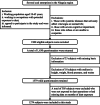Association of dust exposure with anxiety and depression in the occupational population: The important role of sleep duration
- PMID: 39875855
- PMCID: PMC11776242
- DOI: 10.1186/s12889-025-21520-1
Association of dust exposure with anxiety and depression in the occupational population: The important role of sleep duration
Abstract
Background: Mental health issues, particularly anxiety and depression, are increasingly prevalent among the occupational population. Environmental factors, such as dust exposure, may contribute to the worsening of these symptoms. While previous studies have examined the association between dust exposure and mental health, the moderating effect of sleep duration on this link in occupational settings remains under-explored.
Methods: This study was conducted from July to October 2023 at The Fifth People's Hospital of Ningxia and recruited dust-expose d occupational workers from different coal enterprises. After a series of screening 1274 valid subjects were finally included. Binary logistic regression was used to explore the association of dust exposure with anxiety and depression. Generalized additive models (GAM) were constructed to explore the nonlinear relationships between dust exposure duration, sleep duration, and mental health outcomes. Mediating variable contributions were isolated using the Karlson-Holm-Breen (KHB) method and mediated effects models were fitted.
Results: The prevalence of anxiety and depression was found to be 6.44% and 4.24%, respectively. Dust exposure duration was positively associated with both anxiety and depression, while stratification by monthly income level had no significant effect. The contribution of sleep duration to the indirect effect accounted for 21.76% and 43.54% of the total effect of dust exposure duration on anxiety and depression scores, respectively. A nonlinear relationship was observed between dust exposure duration, sleep duration, and the scores of anxiety and depression. In the mediation analysis, shorter sleep duration explained 12.87% of the association between dust exposure duration and anxiety scores.
Conclusions: Dust exposure duration was associated with anxiety and depression, with a nonlinear relationship between them. Changes in sleep duration may effectively influence mental health problems in occupationally dust-exposed populations.
Keywords: Anxiety; Depression; Dust exposure; Mediating effect; Sleep duration.
© 2025. The Author(s).
Conflict of interest statement
Declarations. Ethics approval and consent to participate: The study was approved by the Medical Ethics Review Committee of Ningxia Medical University (No. 2020–564) in compliance with the national ethical review of biomedical research. All respondents provided written informed consent. All procedures performed in studies involving human participants were in accordance with the 1964 Helsinki declaration. Consent for publication: Not applicable. Competing interests: The authors declare no competing interests.
Figures



References
-
- Jacobson NC, Newman MG. Anxiety and depression as bidirectional risk factors for one another: A meta-analysis of longitudinal studies. Psychol Bull. 2017;143(11):1155–200. - PubMed
-
- Diseases GBD, Injuries C. Global incidence, prevalence, years lived with disability (YLDs), disability-adjusted life-years (DALYs), and healthy life expectancy (HALE) for 371 diseases and injuries in 204 countries and territories and 811 subnational locations, 1990–2021: a systematic analysis for the Global Burden of Disease Study 2021. Lancet. 2024;403(10440):2133–61. - PMC - PubMed
-
- Liu X, Cao H, Zhu H, Zhang H, Niu K, Tang N, Cui Z, Pan L, Yao C, Gao Q, et al. Association of chronic diseases with depression, anxiety and stress in Chinese general population: The CHCN-BTH cohort study. J Affect Disord. 2021;282:1278–87. - PubMed
-
- Yang Y, Chen B, Huang P, Wang Y, Zhang L, Cai F. Prevalence and influencing factors of depressive symptoms among rural-to-urban migrant workers in China: A systematic review and meta-analysis. J Affect Disord. 2022;307:11–9. - PubMed
-
- Mei Q, Li W, Feng H, Zhang J, Li J, Yin J, Lukacs-Kornek V, Kurts C, Dai S, Zhao X, et al. Chinese hospital staff in anxiety and depression: Not only comfort patients but also should be comforted - A nationwide cross-sectional study. J Affect Disord. 2024;360:126–36. - PubMed
MeSH terms
Substances
Grants and funding
LinkOut - more resources
Full Text Sources
Medical

